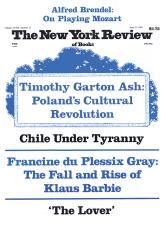In response to:
We Try Harder from the March 14, 1985 issue
To the Editors:
Law Professor Graham Hughes in his review of Tightening the Reins of Justice by Michael H. Graham [NYR, March 14] correctly notes the flaccid quality of English criminal law. He also applauds the large gains that American law has made in protecting the rights of the accused. However, Professor Hughes reveals a woeful ignorance of the actual operation of criminal law in the United States. He assumes that there is no median between the extremes of the guilty plea and an expensive, time consuming jury trial. He acknowledges that a bench trial (without a jury) is available but concludes that this option is seldom exercised. In fact, fewer than 10 percent of all criminal trials in America are heard with a jury. Professor Graham [sic] writes, “the accused has little incentive to waive a jury [trial]….” I have been presiding over both bench and jury trials in major felonies and homicides for thirteen years. Defendants prefer a bench trial when they have any reasonable defense because they and their counsel know that juries seldom understand the presumption of innocence and despite the judge’s instructions, juries will assume that a defendant who fails to testify must be guilty. The old adage known to all practicing lawyers still prevails: “If the law is against you, argue the facts; if the facts are against you, argue the law; if the law and the facts are against you, demand a jury.” The bench trial is alive and well in the criminal courts of America.
Judge Lois G. Forer
Court of Common Pleas
Philadelphia, Pennsylvania
Graham Hughes replies:
I cannot imagine on what data Judge Forer bases her surprising assertion that “fewer than 10 percent of all criminal trials in America are heard with a jury.” As far as I know, there is no decisive compilation of information on this question. The National Center for State Courts has gathered some incomplete figures which will appear in the State Court Caseload Statistics: Annual Report 1981 which the center is about to publish. But even this tabulation has no relevant data for several important states and the information contained in the tables is somewhat cryptic since it is not always clear to what types of offenses it refers. Further tabulation and analysis will be needed before any clear picture emerges.
In my review I was writing in the context of cases where the initial charge is of some gravity—either a felony or a serious misdemeanor. Kamisar, LaFave, and Israel assert in their Modern Criminal Procedure (fifth edition, 1983) at page 23 that of all felony trials in America about 35 to 40 percent are nonjury. Definite figures are available for the federal courts showing that (for the year ending June 1981) only about 17 percent of felony trials were nonjury (United States Department of Justice, Sourcebook of Criminal Justice Statistics, 1982, Table 5.18). It is no doubt possible to arrive at a much higher percentage of nonjury trials by counting dispositions of prosecutions for traffic offenses, petty violations, and breaches of municipal ordinances. Perhaps Judge Forer was making a projection from fragmentary information in that area. But I was not writing about this segment of criminal justice.
Judge Forer may be overly impressed by the state of affairs in Philadelphia where she is a judge. Philadelphia does have a higher percentage of nonjury trials and a lesser number of guilty pleas than almost any other city in the country, a phenomenon to which I was referring in my review when I cited the Harvard Law Review study by Professor Schulhofer. But, even in Philadelphia, the percentage of guilty pleas has increased markedly of late, probably because of the growing professionalism and complexity of the nonjury trial in that city. For more information on what is going on in the court in which she sits I recommend to Judge Forer the important survey contained in Professor Albert W. Alschuler’s study, “Implementing the Criminal Defendant’s Right to Trial: Alternatives to the Plea Bargaining System,” 50 University of Chicago Law Review (1983), p. 931.
In general, Judge Forer’s comments rather miss the point I was making in my review which was that a huge proportion of cases around the country go off on guilty pleas with no trial at all. The thrust of my remarks was not to commend nonjury trials over jury trials as being inherently superior but rather to argue that the availability of swift nonjury trials might be an effective way of reducing the number of guilty pleas. Judge Forer’s figures appear to be very inaccurate but, even if they were correct, they would not demonstrate that the nonjury trial is proving to be a sufficiently attractive alternative to the guilty plea.
This Issue
June 27, 1985



